INSTITUT SUPERIEUR D'ANTHROPOLOGIE
INSTITUT OF ANTHROPOLOGY
COURS ONLINE – COURS A DISTANCE
INSCRIPTIONS OUVERTES
REGISTER NOW
ALLEMAGNE –  Prignitz -A huge hall from the Bronze Age was discovered during excavations near the "royal grave" of Seddin (Prignitz district) northwest of Berlin. As the Brandenburg State Office for Monument Preservation in Wünsdorf announced, it is the largest building of its kind from the Nordic Bronze Age (approx. 2200-800 BC). It was said that the meeting hall of the legendary "King Hinz" was probably excavated with the 31 by 10 meter floor plan. According to state archaeologist Franz Schopper, it is a “really big, spectacular find.” The walls of the building consisted of wooden planks and wattle and daub with clay plaster. The roof was covered with thatch or straw. Due to the estimated building height of seven meters, it is assumed that there were additional floors for living and storage. There was a fireplace centrally located inside the western half of the building. A miniature vessel was recovered on the northern long wall, which is interpreted as a ritual sacrifice. Building dated between 10th and 9th centuries BC The archaeologist Immo Heske from the Georg-August University of Göttingen, who has been scientifically accompanying the excavations for several years, dates the building to between the 10th and 9th centuries BC. Due to its enormous size, it was probably a ruler's seat. In the period from 1800 to 800 BC there were only two other buildings of this type between Denmark and southern Germany, said Heske..
Prignitz -A huge hall from the Bronze Age was discovered during excavations near the "royal grave" of Seddin (Prignitz district) northwest of Berlin. As the Brandenburg State Office for Monument Preservation in Wünsdorf announced, it is the largest building of its kind from the Nordic Bronze Age (approx. 2200-800 BC). It was said that the meeting hall of the legendary "King Hinz" was probably excavated with the 31 by 10 meter floor plan. According to state archaeologist Franz Schopper, it is a “really big, spectacular find.” The walls of the building consisted of wooden planks and wattle and daub with clay plaster. The roof was covered with thatch or straw. Due to the estimated building height of seven meters, it is assumed that there were additional floors for living and storage. There was a fireplace centrally located inside the western half of the building. A miniature vessel was recovered on the northern long wall, which is interpreted as a ritual sacrifice. Building dated between 10th and 9th centuries BC The archaeologist Immo Heske from the Georg-August University of Göttingen, who has been scientifically accompanying the excavations for several years, dates the building to between the 10th and 9th centuries BC. Due to its enormous size, it was probably a ruler's seat. In the period from 1800 to 800 BC there were only two other buildings of this type between Denmark and southern Germany, said Heske..
Archeology: Large Bronze Age hall discovered in the Prignitz News (indonewyork.com)
MAROC – 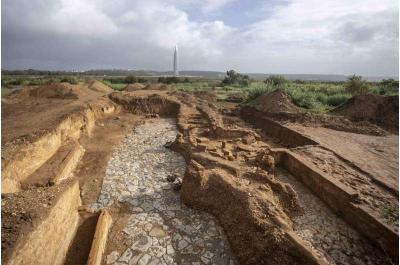
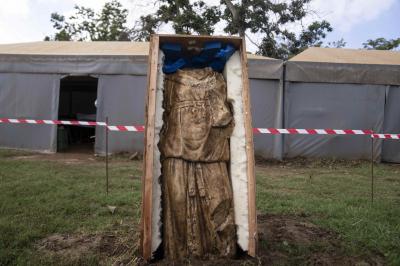 Chellah - Scholars believe the area was first settled by the Phoenicians and emerged as a key Roman empire outpost from the second to fifth century. The fortified necropolis and surrounding settlements were built near the Atlantic Ocean along the banks of the Bou Regreg river. Findings have included bricks inscribed in neo-Punic, a language that predates the Romans' arrival in Morocco. El Khayari and his team of archaeologists said the new discoveries further from the center of Chellah have never been subject to study. At a Friday news conference, they showed reporters a recently discovered statue of a woman—possibly a deity or empress—draped in cloth. They said it was the first such statue discovered in Morocco since the 1960s. They also exhibited a limestone and sunbrick neighborhood. The main excavation site has been closed for renovations since the pandemic and archaeologists have worked on expanding it since March. The footprint—including the extended site presented on Friday—is larger than that of Volubilis, widely visited ruins 111 miles (179 kilometers) east of Rabat.
Chellah - Scholars believe the area was first settled by the Phoenicians and emerged as a key Roman empire outpost from the second to fifth century. The fortified necropolis and surrounding settlements were built near the Atlantic Ocean along the banks of the Bou Regreg river. Findings have included bricks inscribed in neo-Punic, a language that predates the Romans' arrival in Morocco. El Khayari and his team of archaeologists said the new discoveries further from the center of Chellah have never been subject to study. At a Friday news conference, they showed reporters a recently discovered statue of a woman—possibly a deity or empress—draped in cloth. They said it was the first such statue discovered in Morocco since the 1960s. They also exhibited a limestone and sunbrick neighborhood. The main excavation site has been closed for renovations since the pandemic and archaeologists have worked on expanding it since March. The footprint—including the extended site presented on Friday—is larger than that of Volubilis, widely visited ruins 111 miles (179 kilometers) east of Rabat.
Moroccan archaeologists unearth new ruins at Chellah, a tourism-friendly ancient port near Rabat (phys.org)
ISRAEL –  Kebara Cave - Decorating the living space, objects, body and clothes with colour is a widespread human practice. While the habitual use of red mineral pigments (such as iron-oxide, e.g., ochre) by anatomically modern humans started in Africa about 140,000 years ago, the earliest documentation of the use of organic plant or animal-based red pigments is known from only 6,000 years ago. Here, we report the oldest reliable evidence of organic red pigment use 15,000 years ago by the first sedentary hunter-gatherers in the Levant. SEM-EDS and Raman Spectroscopy analyses of 10 red-stained shell beads enabled us to detect and describe the use of a colourant made of Rubiaceae plants roots (Rubia spp., Asperula spp., Gallium spp.) to colour personal adornments from the Early Natufian of Kebara cave, Mount Carmel, Israel. This adds a previously unknown behavioural aspect of Natufian societies, namely a well-established tradition of non-dietary plant processing at the beginning of the sedentary lifestyle. Through a combined multidisciplinary approach, our study broadens the perspectives on the ornamental practices and the chaînes opératoires of pigmenting materials during a crucial period in human history.
Kebara Cave - Decorating the living space, objects, body and clothes with colour is a widespread human practice. While the habitual use of red mineral pigments (such as iron-oxide, e.g., ochre) by anatomically modern humans started in Africa about 140,000 years ago, the earliest documentation of the use of organic plant or animal-based red pigments is known from only 6,000 years ago. Here, we report the oldest reliable evidence of organic red pigment use 15,000 years ago by the first sedentary hunter-gatherers in the Levant. SEM-EDS and Raman Spectroscopy analyses of 10 red-stained shell beads enabled us to detect and describe the use of a colourant made of Rubiaceae plants roots (Rubia spp., Asperula spp., Gallium spp.) to colour personal adornments from the Early Natufian of Kebara cave, Mount Carmel, Israel. This adds a previously unknown behavioural aspect of Natufian societies, namely a well-established tradition of non-dietary plant processing at the beginning of the sedentary lifestyle. Through a combined multidisciplinary approach, our study broadens the perspectives on the ornamental practices and the chaînes opératoires of pigmenting materials during a crucial period in human history.
Plant-based red colouration of shell beads 15,000 years ago in Kebara Cave, Mount Carmel (Israel) | PLOS ONE
CHINE –  Huzhou - Ruins of a magnificent building complex believed to have been constructed in the late Shang Dynasty (1600 B.C.-1046 B.C.) have been unearthed in east China's Zhejiang Province, including a 3,400-square-meter ritual site, pottery workshops and relics. This was reported by The Xinhua News Agency. Located at the Pishan site, Wuxing District of Huzhou City, the settlement cluster where the buildings were discovered was moated by a ring trench. It dates back to about 3,000 years ago. The Pishan site is currently Zhejiang's biggest archaeological site featuring remnants of ancient China's Xia (2070 B.C.-1600 B.C.) and Shang dynasties. The settlement cluster covers about 330,000 square meters in total. Bronzeware, potteries and primitive porcelains were also unearthed at the site. "This new discovery helps provide abundant physical evidence of the influence of the Shang culture on regions south of the Yangtze River. Together with the renowned Sanxingdui Ruins and other sites in the Yangtze River basin, the discovery can help prove that ancestors in the river basin area created diverse regional cultures and ushered in a rapid development period at that time", – said Luo Rupeng from Zhejiang's provincial institute of cultural relics and archaeology. "The magnificent buildings also indicate that the Pishan site was previously a center of the regional political civilization at the basin of the Dongtiaoxi, a local stream. The center's influence may have extended to a broader area including the Taihu Lake basin, which may be confirmed by further studies", – said Xu Lianggao, a researcher from the Institute of Archaeology, Chinese Academy of Social Sciences.
Huzhou - Ruins of a magnificent building complex believed to have been constructed in the late Shang Dynasty (1600 B.C.-1046 B.C.) have been unearthed in east China's Zhejiang Province, including a 3,400-square-meter ritual site, pottery workshops and relics. This was reported by The Xinhua News Agency. Located at the Pishan site, Wuxing District of Huzhou City, the settlement cluster where the buildings were discovered was moated by a ring trench. It dates back to about 3,000 years ago. The Pishan site is currently Zhejiang's biggest archaeological site featuring remnants of ancient China's Xia (2070 B.C.-1600 B.C.) and Shang dynasties. The settlement cluster covers about 330,000 square meters in total. Bronzeware, potteries and primitive porcelains were also unearthed at the site. "This new discovery helps provide abundant physical evidence of the influence of the Shang culture on regions south of the Yangtze River. Together with the renowned Sanxingdui Ruins and other sites in the Yangtze River basin, the discovery can help prove that ancestors in the river basin area created diverse regional cultures and ushered in a rapid development period at that time", – said Luo Rupeng from Zhejiang's provincial institute of cultural relics and archaeology. "The magnificent buildings also indicate that the Pishan site was previously a center of the regional political civilization at the basin of the Dongtiaoxi, a local stream. The center's influence may have extended to a broader area including the Taihu Lake basin, which may be confirmed by further studies", – said Xu Lianggao, a researcher from the Institute of Archaeology, Chinese Academy of Social Sciences.
Ruins of 3,000-year-old building complex found in east China | Ukrainian news (ukranews.com)
PORTUGAL –  Alto da Vigia - The ruins of a second Islamic ‘ribat’ mosque dating back to the 11th and 12th centuries have been discovered at the Alto da Vigia archaeological site next to the town of Praia das Maçãs, located on one of the most beautiful beaches of Portugal’s Sintra coastline. A ribāṭ is an Arabic termThe word ribat in its abstract refers to the voluntary defense of Islam, which is why ribats were originally used to house those who fought to defend Islam. In a statement, the Sintra municipality revealed that “research work continues at the Alto da Vigia archaeological site, next to Praia das Maçãs, having now identified and excavated the ruins of a second Islamic ‘ribat’ mosque dating from the 11th and 12th centuries”. “This place would be both a place of prayer and surveillance of the coast against the risk of attack, particularly by Christian forces”, the statement reads. According to information provided by Lusa News Agency, “this find reinforces the importance of this sacred space for Islam, documenting a type of architectural reality for which only two other examples are known in the entire Iberian Peninsula: one in Aljezur and another near Alicante, in Spain”.
Alto da Vigia - The ruins of a second Islamic ‘ribat’ mosque dating back to the 11th and 12th centuries have been discovered at the Alto da Vigia archaeological site next to the town of Praia das Maçãs, located on one of the most beautiful beaches of Portugal’s Sintra coastline. A ribāṭ is an Arabic termThe word ribat in its abstract refers to the voluntary defense of Islam, which is why ribats were originally used to house those who fought to defend Islam. In a statement, the Sintra municipality revealed that “research work continues at the Alto da Vigia archaeological site, next to Praia das Maçãs, having now identified and excavated the ruins of a second Islamic ‘ribat’ mosque dating from the 11th and 12th centuries”. “This place would be both a place of prayer and surveillance of the coast against the risk of attack, particularly by Christian forces”, the statement reads. According to information provided by Lusa News Agency, “this find reinforces the importance of this sacred space for Islam, documenting a type of architectural reality for which only two other examples are known in the entire Iberian Peninsula: one in Aljezur and another near Alicante, in Spain”.
A Ribat Mosque shares space with the Roman sanctuary dedicated to Sun and Ocean was discovered in Portugal - Arkeonews
KAZAKHSTAN – 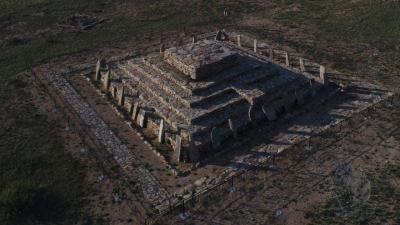 Karaganda - A pyramid belonging to the Scythian-Saka period was found in the Karaganda region of Kazakhstan. Experts announced that the Karajartas mausoleum belongs to a ruler from the Begazı Dandibay period, which was the last phase of the Andronovo period. The pyramid, which was excavated over the course of four excavation seasons by archaeologists from Karaganda University, is situated atop a hill overlooking the Taldy River in the Shet district of Karaganda. From the National Museum of the Republic of Kazakhstan, Dr. Aibar Kassenali made the first evaluation of the discovered pyramid to TRT Haber. Dr. Aibar Kassenali announced that according to the results of carbon 14 analyses carried out on the finds, the pyramid structure was dated between the 14th and 12th centuries before Christ (BC). Dr. Kassenali explains the meaning of this dating: “The presence of multiple pyramidal stepped mausoleums detected in the region shows that the Taldı River valley, located in the Sari Arka steppes, was used by the Andronovo communities in the Bronze Age as the valley of kings where their great leaders were buried, like the Nile Valley in Egypt. ” he explained with his words. Dr Aibar Kassenali said that when the findings in the burial chamber were examined, the steppe pyramid may have been built on behalf of a local ruler who ruled the Kazakh steppes during the Andronovo period. Dr. Aibar Kassenali said, “Looking at the cut stones found in the pyramid, the size of the mausoleum, and the fact that such a huge structure was built in the Bronze Age in a very arid region such as the steppe is an indication of the high understanding of art and rich spiritual beliefs that the Begazi Dandibay communities have reached.” Excavations in the region have also uncovered a proto-city settlement also belonging to a Begazı Dandibay community. Dr. Çınar said, “This settlement, which extends over an area of 15 hectares, existed chronologically in the same historical period as Troy 4 in Asia Minor, the Early Mycenaean period in mainland Greece, and the advanced period of the Middle Kingdom in Egypt. The settlement has a series of walls, a planned street network, and water collection systems.” The researchers believe that the Begazı Dandibay communities demonstrate a close relationship with the Proto-Turkish culture, which is derived from the Karasuk culture of Southern Siberia. As a manifestation of traditional Turkish religious belief, the corridors leading to the burial chamber, particularly in the mausoleums of the Begazı Dandibay phase, always open towards the direction of sunrise. The round-shaped ceramic vessels found in the graves from this period symbolize a cultural continuity in the steppe environment. They represent ritual vessels from the Scythian-Saka period, and in later periods, they evolved into the archaic versions of traditional cauldrons commonly seen among Turkic tribes from the time of the Asian Huns onwards. It is known that among the Turkic runic script characters from the Göktürk period, there are many tamga pictograms associated with the Andronovo and Begazı Dandibay phases. Furthermore, the geometric decorations and tamga-type characters (A tamga or tamgha was an abstract seal or stamp used by Eurasian nomads and by cultures influenced by them) found in burial sites are present in the art of medieval Turkic tribes, indicating ethnographic and historical continuity.
Karaganda - A pyramid belonging to the Scythian-Saka period was found in the Karaganda region of Kazakhstan. Experts announced that the Karajartas mausoleum belongs to a ruler from the Begazı Dandibay period, which was the last phase of the Andronovo period. The pyramid, which was excavated over the course of four excavation seasons by archaeologists from Karaganda University, is situated atop a hill overlooking the Taldy River in the Shet district of Karaganda. From the National Museum of the Republic of Kazakhstan, Dr. Aibar Kassenali made the first evaluation of the discovered pyramid to TRT Haber. Dr. Aibar Kassenali announced that according to the results of carbon 14 analyses carried out on the finds, the pyramid structure was dated between the 14th and 12th centuries before Christ (BC). Dr. Kassenali explains the meaning of this dating: “The presence of multiple pyramidal stepped mausoleums detected in the region shows that the Taldı River valley, located in the Sari Arka steppes, was used by the Andronovo communities in the Bronze Age as the valley of kings where their great leaders were buried, like the Nile Valley in Egypt. ” he explained with his words. Dr Aibar Kassenali said that when the findings in the burial chamber were examined, the steppe pyramid may have been built on behalf of a local ruler who ruled the Kazakh steppes during the Andronovo period. Dr. Aibar Kassenali said, “Looking at the cut stones found in the pyramid, the size of the mausoleum, and the fact that such a huge structure was built in the Bronze Age in a very arid region such as the steppe is an indication of the high understanding of art and rich spiritual beliefs that the Begazi Dandibay communities have reached.” Excavations in the region have also uncovered a proto-city settlement also belonging to a Begazı Dandibay community. Dr. Çınar said, “This settlement, which extends over an area of 15 hectares, existed chronologically in the same historical period as Troy 4 in Asia Minor, the Early Mycenaean period in mainland Greece, and the advanced period of the Middle Kingdom in Egypt. The settlement has a series of walls, a planned street network, and water collection systems.” The researchers believe that the Begazı Dandibay communities demonstrate a close relationship with the Proto-Turkish culture, which is derived from the Karasuk culture of Southern Siberia. As a manifestation of traditional Turkish religious belief, the corridors leading to the burial chamber, particularly in the mausoleums of the Begazı Dandibay phase, always open towards the direction of sunrise. The round-shaped ceramic vessels found in the graves from this period symbolize a cultural continuity in the steppe environment. They represent ritual vessels from the Scythian-Saka period, and in later periods, they evolved into the archaic versions of traditional cauldrons commonly seen among Turkic tribes from the time of the Asian Huns onwards. It is known that among the Turkic runic script characters from the Göktürk period, there are many tamga pictograms associated with the Andronovo and Begazı Dandibay phases. Furthermore, the geometric decorations and tamga-type characters (A tamga or tamgha was an abstract seal or stamp used by Eurasian nomads and by cultures influenced by them) found in burial sites are present in the art of medieval Turkic tribes, indicating ethnographic and historical continuity.
A 3,400-year-old Pyramid from the Scythian-Saka period found in Karaganda region of Kazakhstan - Arkeonews
ITALIE – 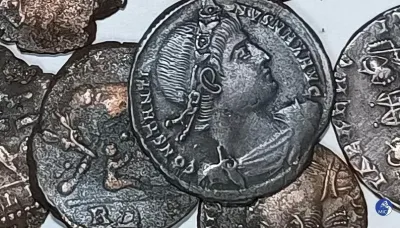 Arzachena - A diver spotted something metallic at the bottom of the sea off the town of Arzachena in the Sassari province of northern Sardinia, the second-largest island off the coast of Italy, leading to the discovery of tens of thousands of ancient bronze coins. The coins were discovered in seagrass not far from the island’s northeastern shore and date to the first half of the fourth century. The exact number of coins recovered has yet to be determined because they are being sorted. According to a first estimate, made based on the overall weight of the discovery, the number of large bronze coins found would be between 30,000 and 50,000 specimens, more than those found in 2013 in the United Kingdom, in Seaton. In addition to the coins, walls of amphorae of African production and, in smaller numbers, of oriental production were identified in the deposit. The chronological context of the coins can be found in a period between 324 (Licinius coinage) and 340 AD. Dating is confirmed by the presence of the coinage of Constantine the Great and that of all the other members of the family present as caesars but above all by the absence of centenionales, minted starting from 346 AD. The recovered follis group comes from almost all the mints of the empire active in that period except Antioch, Alexandria, and Carthage.
Arzachena - A diver spotted something metallic at the bottom of the sea off the town of Arzachena in the Sassari province of northern Sardinia, the second-largest island off the coast of Italy, leading to the discovery of tens of thousands of ancient bronze coins. The coins were discovered in seagrass not far from the island’s northeastern shore and date to the first half of the fourth century. The exact number of coins recovered has yet to be determined because they are being sorted. According to a first estimate, made based on the overall weight of the discovery, the number of large bronze coins found would be between 30,000 and 50,000 specimens, more than those found in 2013 in the United Kingdom, in Seaton. In addition to the coins, walls of amphorae of African production and, in smaller numbers, of oriental production were identified in the deposit. The chronological context of the coins can be found in a period between 324 (Licinius coinage) and 340 AD. Dating is confirmed by the presence of the coinage of Constantine the Great and that of all the other members of the family present as caesars but above all by the absence of centenionales, minted starting from 346 AD. The recovered follis group comes from almost all the mints of the empire active in that period except Antioch, Alexandria, and Carthage.
Tens of Thousands of Ancient Bronze Coins Dating from the 4th Century Discovered Off Sardinia - Arkeonews
JAPON –  Maebashi - In an excavation at the Sosha Village East 03 archaeological site in Maebashi City, Japan, archaeologists stumbled upon a remarkable discovery – a cache of over 100,000 ancient coins, some of which are of Chinese origin and are more than 2,000 years old. These coins include the “Ban Liang,”(coin from 175 B.C.) China’s first unified currency, as well as others dating from the seventh to the thirteenth centuries. What’s more, they were bundled in groups of around 100 coins and secured with straw cords known as “sashi.” The coins were probably buried quickly because the location was close to opulent homes belonging to influential people in medieval Japan, maybe as a precaution against impending war. The unearthed coins were found in an area approximately 60 centimeters high and one meter wide, with a staggering 1,060 bundles of these sashi clusters. Some bundles contained evidence of 10 sashi, equivalent to roughly a thousand coins, all arranged with traces of rice straw mats.A thorough examination of 334 coins from the haul revealed an astounding variety of 44 different currency types. These coins originated from as far back as China’s Western Han Dynasty, extending to the Southern Song Dynasty. The oldest among them, the “Ban Liang,” dates back to 175 B.C., with distinct characteristics including a 2.3-centimeter diameter, a 7-millimeter square hole in the center, and a thickness of 1 millimeter, featuring the inscriptions “liang” on the left and “ban” on the right The most recent coin in this treasure trove was minted in 1265 during the Southern Song Dynasty, leading experts to believe that these coins were hidden during the turbulent Kamakura period (1185-1333). It should be noted that the dating results are preliminary and may be refined through additional research. .
Maebashi - In an excavation at the Sosha Village East 03 archaeological site in Maebashi City, Japan, archaeologists stumbled upon a remarkable discovery – a cache of over 100,000 ancient coins, some of which are of Chinese origin and are more than 2,000 years old. These coins include the “Ban Liang,”(coin from 175 B.C.) China’s first unified currency, as well as others dating from the seventh to the thirteenth centuries. What’s more, they were bundled in groups of around 100 coins and secured with straw cords known as “sashi.” The coins were probably buried quickly because the location was close to opulent homes belonging to influential people in medieval Japan, maybe as a precaution against impending war. The unearthed coins were found in an area approximately 60 centimeters high and one meter wide, with a staggering 1,060 bundles of these sashi clusters. Some bundles contained evidence of 10 sashi, equivalent to roughly a thousand coins, all arranged with traces of rice straw mats.A thorough examination of 334 coins from the haul revealed an astounding variety of 44 different currency types. These coins originated from as far back as China’s Western Han Dynasty, extending to the Southern Song Dynasty. The oldest among them, the “Ban Liang,” dates back to 175 B.C., with distinct characteristics including a 2.3-centimeter diameter, a 7-millimeter square hole in the center, and a thickness of 1 millimeter, featuring the inscriptions “liang” on the left and “ban” on the right The most recent coin in this treasure trove was minted in 1265 during the Southern Song Dynasty, leading experts to believe that these coins were hidden during the turbulent Kamakura period (1185-1333). It should be noted that the dating results are preliminary and may be refined through additional research. .
Archaeologists uncovered over 100,000 ancient coins, some more than 2,000 years old - Arkeonews
ALBANIE – 
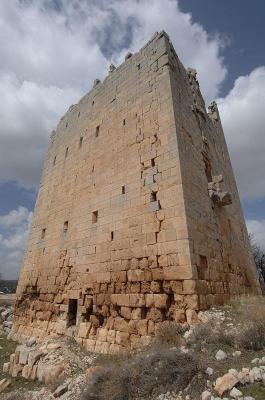 Bushat - Excavations of an ancient site in Albania, first discovered by archaeologists in 2018, have revealed further details about a lost ancient city that ancient Greeks could have built. Archaeologists, led by Piotr Dyczek and Saimir Shpuza, have uncovered at least three more buildings on a site located near the modern-day village of Bushat in Albania. The ancient city was built in an area primarily inhabited by the Illyrians. However, Illyria was also home to several ancient Greek colonies. Findings from the site bear Greek and Illyrian influences. Certain features of the ancient city suggest a Greek connection. The settlement’s defenses are typically Hellenistic. Archaeologists found a gate flanked by two large bastions, and the city walls would have been more than three meters wide. Some buildings were found to have been covered by specially shaped tiles in a particular ancient Greek style. The researchers are unsure what function these buildings served. Everyday items in the Greek style were also discovered. Drinking vessels called skyphoi (singular: skyphos) were used by the city’s inhabitants. Ancient Greeks often drank wine with a skyphos. It was a cup with two handles, typically decorated with scenes from mythology or everyday life. Another ancient city believed to have been founded by the Greeks is close to the site at Bushat. According to the ancient Greek historian Diodorus, nearby Lissos was founded by Dionysius of Syracuse in 385 BC. If the archaeological site at Bushrat was once a Greek polis (city), it is not certain where in the Greek world its founders originally came from. A connection to Lissos is possible.
Bushat - Excavations of an ancient site in Albania, first discovered by archaeologists in 2018, have revealed further details about a lost ancient city that ancient Greeks could have built. Archaeologists, led by Piotr Dyczek and Saimir Shpuza, have uncovered at least three more buildings on a site located near the modern-day village of Bushat in Albania. The ancient city was built in an area primarily inhabited by the Illyrians. However, Illyria was also home to several ancient Greek colonies. Findings from the site bear Greek and Illyrian influences. Certain features of the ancient city suggest a Greek connection. The settlement’s defenses are typically Hellenistic. Archaeologists found a gate flanked by two large bastions, and the city walls would have been more than three meters wide. Some buildings were found to have been covered by specially shaped tiles in a particular ancient Greek style. The researchers are unsure what function these buildings served. Everyday items in the Greek style were also discovered. Drinking vessels called skyphoi (singular: skyphos) were used by the city’s inhabitants. Ancient Greeks often drank wine with a skyphos. It was a cup with two handles, typically decorated with scenes from mythology or everyday life. Another ancient city believed to have been founded by the Greeks is close to the site at Bushat. According to the ancient Greek historian Diodorus, nearby Lissos was founded by Dionysius of Syracuse in 385 BC. If the archaeological site at Bushrat was once a Greek polis (city), it is not certain where in the Greek world its founders originally came from. A connection to Lissos is possible.
Ancient City Discovered in Albania Could Have Greek Origins (greekreporter.com)